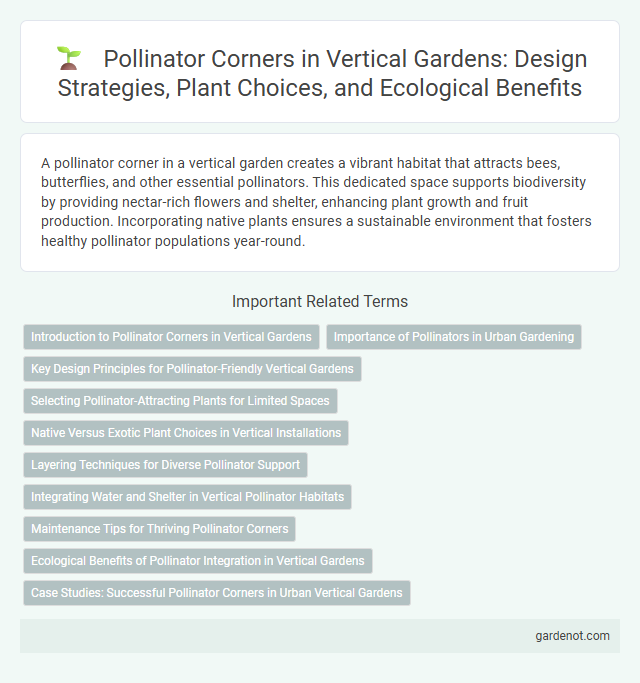A pollinator corner in a vertical garden creates a vibrant habitat that attracts bees, butterflies, and other essential pollinators. This dedicated space supports biodiversity by providing nectar-rich flowers and shelter, enhancing plant growth and fruit production. Incorporating native plants ensures a sustainable environment that fosters healthy pollinator populations year-round.
Introduction to Pollinator Corners in Vertical Gardens
Pollinator corners in vertical gardens create essential habitats for bees, butterflies, and other pollinating insects by incorporating native flowering plants and nectar-rich species. These specialized sections enhance biodiversity and improve plant pollination rates, leading to more robust growth and increased garden productivity. Strategic placement of pollinator-friendly flora within vertical spaces ensures effective habitat utilization and supports urban ecological balance.
Importance of Pollinators in Urban Gardening
Pollinators such as bees, butterflies, and hummingbirds play a vital role in urban gardening by enhancing plant reproduction and biodiversity within vertical gardens. Their activity increases fruit set and flower development, contributing to higher yields and healthier ecosystems in city environments. Integrating a pollinator corner in vertical gardens supports urban agriculture sustainability and boosts ecological balance.
Key Design Principles for Pollinator-Friendly Vertical Gardens
In designing a pollinator-friendly vertical garden, prioritize native flowering plants that provide abundant nectar and pollen throughout the growing season. Incorporate varied plant heights and structures to create diverse habitats, supporting different pollinator species such as bees, butterflies, and hummingbirds. Ensure adequate sunlight, proper watering systems, and the use of pesticide-free organic soil to enhance plant health and attract pollinators effectively.
Selecting Pollinator-Attracting Plants for Limited Spaces
Choosing pollinator-attracting plants for a vertical garden involves selecting compact, nectar-rich species like lavender, bee balm, and butterfly bush that thrive in small spaces. Incorporating a mix of flowering plants with staggered bloom times ensures a continuous food source for bees, butterflies, and hummingbirds. Using modular planting systems with deep root pockets supports healthy growth while maximizing vertical space efficiency.
Native Versus Exotic Plant Choices in Vertical Installations
Pollinator corners in vertical gardens thrive best when incorporating native plants, as these species offer tailored nectar and pollen sources that support local bee, butterfly, and bird populations. Native plants adapt naturally to regional climates and soil conditions, enhancing the vertical installation's sustainability and resilience while promoting biodiversity. Exotic plants may introduce attractive aesthetics but often lack the ecological compatibility needed to sustain native pollinators effectively within vertical garden ecosystems.
Layering Techniques for Diverse Pollinator Support
A pollinator corner utilizes layering techniques by incorporating ground covers, mid-height flowering plants, and tall shrubs to create diverse habitats for bees, butterflies, and hummingbirds. This stratified approach maximizes nectar availability and nesting opportunities throughout the vertical garden. Selecting native flowering species with staggered bloom times ensures continuous support for pollinators across multiple seasons.
Integrating Water and Shelter in Vertical Pollinator Habitats
Vertical pollinator habitats enhance biodiversity by integrating water sources such as drip trays or misting systems that maintain humidity and attract pollinators like bees and butterflies. Sheltered niches created with dense foliage or built-in cavities offer protection from predators and harsh weather, promoting extended pollinator visits. Combining these elements in vertical gardens supports pollinator health, improves plant pollination rates, and contributes to urban ecosystem resilience.
Maintenance Tips for Thriving Pollinator Corners
Regular watering and selecting native flowering plants ensure a thriving pollinator corner in vertical gardens. Pruning spent blooms promotes continuous flowering, attracting bees and butterflies throughout the season. Incorporating organic mulch helps retain moisture and suppress weeds, supporting a healthy habitat for pollinators.
Ecological Benefits of Pollinator Integration in Vertical Gardens
Pollinator integration in vertical gardens enhances biodiversity by providing essential habitats for bees, butterflies, and other pollinators, which are crucial for ecosystem health. These vertical ecosystems facilitate natural pollination processes, boosting plant reproduction and yield while reducing reliance on chemical fertilizers. Incorporating pollinator-friendly plants also supports urban ecological networks, improving air quality and promoting resilience against environmental stressors.
Case Studies: Successful Pollinator Corners in Urban Vertical Gardens
Pollinator corners in urban vertical gardens have demonstrated increased biodiversity by attracting native bees, butterflies, and hummingbirds through strategic planting of nectar-rich flowers and host plants. Case studies from cities like New York and Tokyo reveal that integrating vertical green walls with pollinator-friendly species significantly boosts urban pollination networks and supports local ecosystems. Data from these projects indicate a 40% rise in pollinator visitation rates, contributing to enhanced urban agriculture and improved air quality.
Pollinator corner Infographic

 gardenot.com
gardenot.com